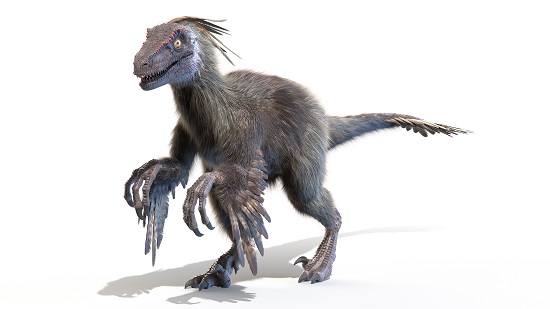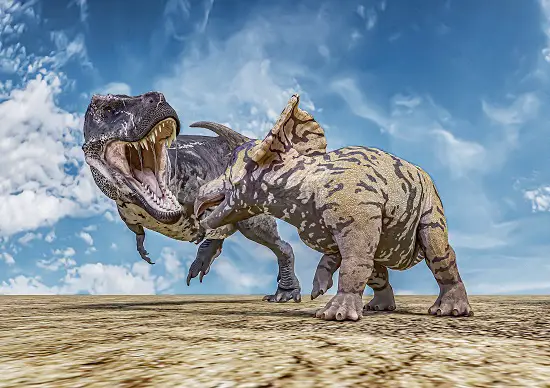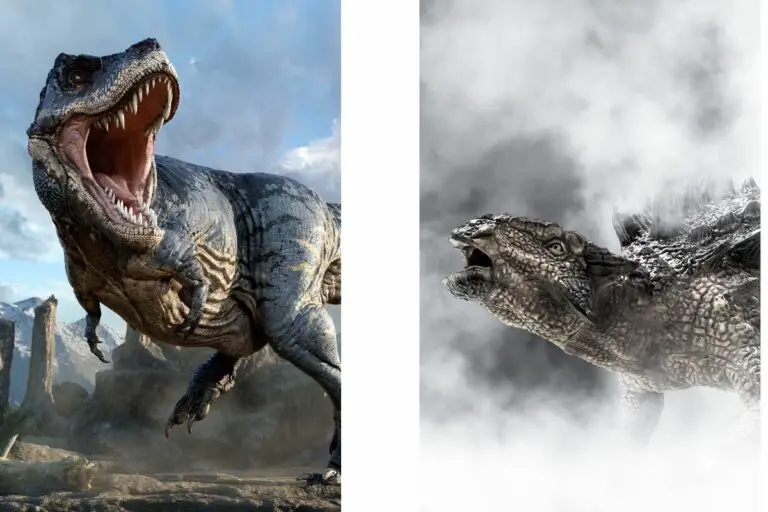What Is The Difference Between Bird Hipped And Lizard Hipped Dinosaurs
Sixty-five million years ago, dinosaurs were the dominant species roaming the earth. Since then, scientists have tried to understand and piece together their life histories and physical structures to understand them better.
One of the most prevalent anatomical divisions proposed in 1888 and still important today is the categorization of dinosaurs into two divisions: lizard hipped and bird-hipped. So what are some of the differences between these two categories of dinosaurs?
Three primary parts comprise a dinosaur hip, the ilium, the ischium, and the pubis. In lizard-hipped dinosaurs, the pubis is in a forward-facing direction resembling the hips of a lizard. In the bird-hipped dinosaur, the pubis is in a backward-facing position, similar to the hips of a bird.
To better understand the difference between lizard hipped and bird-hipped dinosaurs, it would be best to go into more detail about what these two categories mean. Firstly, a complete description of how the ilium, ischium, and pubis fit together would be beneficial, and then what it would mean anatomically for your pubis to be facing either forwards or backward.

Bird-Hipped & Lizard-Hipped Dinosaurs: The Difference
In 1888 a paleontologist named Harry Govier Seely put forth a theoretical framework that would remain important until today. This framework divided dinosaurs into two distinct categories based on the structure of their hip bones, with the fundamental difference being the orientation of their pubic bones.
The first was saurischian, or lizard-hipped dinosaurs, with a hip orientation similar to modern lizard hips. The second was ornithischians, bird-hipped dinosaurs with a hip orientation comparable to modern birds.
Before we discuss the differences between bird-hipped and lizard-hipped dinosaurs, it might be best to discuss the anatomy of the hip bone structure first. This way, we can fully understand the topic we are discussing.
You can separate a dinosaur’s hip into three primary bones. The first is the ilium, which you can describe as the hip’s prominent, upper protruded ridge. The ischium is the smaller spine-like bone that runs behind and below the ilium. The pubis, the most important bone for our discussions, is described as a slender extension of the lower hip that can either be in a forward or backward-facing position.
Now that we have a basic understanding of which bones make up the hip, we can look at the difference between bird-hipped and lizard-hipped dinosaurs.
Examples of Bird hipped and Lizard hipped Dinosaurs.
We have a table below to give a clearer picture of which dinosaurs were which as it can get a little confusing. We have kept the table simple and just split it into two columns – Bird and Lizard type hips.
Table 1: Examples of Bird and lizard hipped dinosaurs.
| Bird Hipped Dinosaurs | Lizard Hipped Dinosaurs |
| Triceratops | Brachiosaurus |
| Stegosaurus | Argentinosaurus |
| Ankylosaurus | Diplodocus |
| Iguanodon | Tyrannosaurus Rex |
| Kentrosaurus | Allosaurus |
| Parasolophus | Velociraptor |
| Edmontosaurus | Compsognathus |
| Camptosaurus | Apatosaurus |
| Pachycephalosaurus | Pachycephalosaurus |
| Pentaceratops | Giganotosaurus |
| Corythosaurus | Therizinosaurus |
| Cedarpelta | Coelophysis |
What Is A Bird Hipped Dinosaur?
One thing to note is that bird-hipped dinosaurs (ornithischians) are not related to modern birds. They were only named such because their hip structure resembled the hips of modern-day birds.
In the bird-hipped dinosaurs, their pubis is what we describe as reversed, which means that it points towards the tail, parallel and alongside the ischium. The pubis bone is also smaller in these types of dinosaurs.

You can also note that the pubis bone in the bird-hipped dinosaurs had a forward-facing section, resulting in the formation of a pocket that could fit the ilio-femoralis muscle. This muscle wrapped around the hip with a tendon which helped insert it onto the femur’s external head. This setup gave them much more flexibility, allowing them to kick outwards.
Most bird-hipped dinosaurs were herbivores. Most of them traveled on four legs. Some of the bird-hipped dinosaurs even traveled in herds. Triceratops and Ankylosaurs are just two examples of ornithischians.
What Is A Lizard Hipped Dinosaur?
Lizard hipped dinosaurs (saurischian) were bipedal, standing on their hind legs. In these dinosaurs, the pubis extends downwards and forwards. This position is at an angle to the ischium and resembles a triangle.
This hip bone structure is a typical setup for modern-day lizards. Many of them were also carnivorous, preferring a diet consisting of meat (in other words, other dinosaurs).

A few other distinguishing factors about these dinosaurs are that most had asymmetrical fingers, grasping hands, and a long, mobile neck.
One thing that might confuse many people here is that scientists believe that birds evolved from a group of these lizard hipped dinosaurs called coelurosaurs, which eventually evolved and developed the bird-like hip structure at a later stage.
Differences Between Bird-Hipped And Lizard Hipped Dinosaurs
The fundamental difference between these two categories of dinosaurs was their hip bone structure, bird-hipped dinosaurs had a pubis facing forwards, and lizard-hipped dinosaurs had a pubis facing backward.
Regarding the functional differences between these two types of dinosaurs, their different facing pubic bones enabled them to walk differently. The lizard hipped dinosaurs could walk in a more upright position aiding their bipedalism, and the bird-hipped dinosaurs were better suited to walking as quadrupeds, which means that they could happily walk on all four of their limbs.
Even though the different hip bone structures were better suited to different ways of walking, it doesn’t mean that the bird-hipped dinosaurs could not remain bipedal. It just means they did not stand in as much of an upright position when they moved.
All bird-hipped dinosaurs were herbivores, and all carnivores were lizard-hipped. Although not all lizard hipped dinosaurs were carnivores, some later evolved backward-facing pubic bones, which better suited their acquired herbivorous diet.
The bird-hipped pubic bone structure was better suited to a herbivorous diet as it allowed extra room for the more extensive and advanced digestive system that herbivores required to digest the plant matter they were consuming.
A herbivorous diet is much harder to digest than meats, so herbivores needed more guts to extend the length of time the digestive system had to access the plant matter’s minerals and nutrients.
The Evolution Of Bird-Hipped And Lizard Hipped Dinosaurs
An interesting factor here is that bird-hipped dinosaurs have no relation to birds. Studies show that birds are descendants of the lizard-hipped dinosaurs.
It is also worth noting that once the bird-hipped dinosaurs evolved backward-facing pubis, none of their descendants ever reverted to forward-facing pubic bones. Some of the descendants of the lizard hipped dinosaurs, on the other hand, did later evolve backward-facing pubic bones, which is how descendants of these dinosaurs eventually evolved into modern-day birds.
Conclusion
The fundamental difference between bird-hipped (ornithischians) and lizard-hipped (saurischian) dinosaurs was the orientation of their pubic bones. In bird-hipped dinosaurs, the pubis faced downward towards the tail parallel and alongside the ischium. In the lizard-hipped category, the pubis bone faced downward and at an angle to the ischium.
Most bird-hipped dinosaurs were quadrupedal and herbivorous, whereas most lizard-hipped dinosaurs were bipedal and carnivorous. However, some lizard hipped dinosaurs evolved, acquiring the bird-hipped pubis, and became herbivorous even though they were still bipedal.
References:
- https://www.smithsonianmag.com/science-nature/dinosaur-division-is-all-in-the-hips-20477310/#:~:text=The%20hips%20of%20dinosaurs%20with,%E2%80%9Cbird%2Dhipped%E2%80%9D).
- https://www.youtube.com/watch?v=-r1bKHQBoRU
- https://www.quora.com/What-is-the-functional-difference-between-the-hip-structures-of-saurischian-lizard-hipped-and-ornithischian-bird-hipped-dinosaurs-Why-do-the-modern-descendants-of-saurischians-birds-have-different-hips-from-their-ancestors
- https://www.quora.com/How-do-we-know-bird-hipped-and-lizard-hipped-dinosaurs-were-related
- https://ucmp.berkeley.edu/diapsids/dinomm.html
- https://www.allthescience.org/what-is-the-difference-between-saurischians-and-ornithischians.htm
- https://animals.howstuffworks.com/dinosaurs/types-of-dinosaurs.htm
- https://blogs.scientificamerican.com/laelaps/the-secret-to-dinosaur-hip-shape/
- https://ucmp.berkeley.edu/diapsids/saurischia/saurischia.html#:~:text=The%20Saurischian%20Dinosaurs,ilium%2C%20ischium%2C%20and%20pubis.
- https://www.britannica.com/animal/ornithischian
Hi, I am Roy Ford a General Studies and English Teacher who has taught all over the world. What started as a fossil collection became a great way to teach, motivate and inspire students of all ages and all over the world about dinosaurs and from that and children’s love of dinosaurs came the site dinosaur facts for kids, a resource for all ages.










